Ultrasonic-Aided Co-Precipitation of Tannins and Chitosan Ammonium Salt on Cotton Fabric for Antimicrobial and Ultraviolet-Shielding Properties: An Efficient, Colourless, and Eco-Finishing Strategy
Abstract
:1. Introduction
2. Materials and Methods
2.1. Materials
2.2. Methods
2.2.1. Cationisation
2.2.2. Adsorption Kinetics Study
2.2.3. CCD Experimental Design
2.2.4. Characterisation
3. Results
3.1. UV–Vis Adsorption Study
3.2. Cationisation and Co-Deposition
3.3. Adsorption Kinetics Study and Time Saving Estimation
3.4. CCD Analysis
3.5. Characterisations
3.5.1. Colour Features
3.5.2. Proposed Interactive Scheme
3.5.3. Antibacterial Activity
4. Conclusions
Author Contributions
Funding
Institutional Review Board Statement
Informed Consent Statement
Data Availability Statement
Conflicts of Interest
References
- Ahmed, F.; Mondal, M.I.H. Introduction to natural fibres and textiles. In Fundamentals of Natural Fibres and Textiles; Woodhead Publishing: Sawston, UK, 2021; pp. 1–32. [Google Scholar] [CrossRef]
- Rehan, M.; Ahmed-Farid, O.A.; Ibrahim, S.R.; Hassan, A.A.; Abdelrazek, A.M.; Khafaga, N.I.M.; Khattab, T.A. Green and Sustainable Encapsulation of Guava Leaf Extracts (Psidium guajava L.) into Alginate/Starch Microcapsules for Multifunctional Finish over Cotton Gauze. ACS Sustain. Chem. Eng. 2019, 7, 18612–18623. [Google Scholar] [CrossRef]
- Zhang, Y.; Shahid ul, I.; Rather, L.J.; Li, Q. Recent advances in the surface modification strategies to improve functional finishing of cotton with natural colourants—A review. J. Clean. Prod. 2022, 335, 130313. [Google Scholar] [CrossRef]
- Alebeid, O.K.; Zhao, T. Review on: Developing UV protection for cotton fabric. J. Text. Inst. 2017, 108, 2027–2039. [Google Scholar] [CrossRef]
- Zhang, S.; Yang, X.; Tang, B.; Yuan, L.; Wang, K.; Liu, X.; Zhu, X.; Li, J.; Ge, Z.; Chen, S. New insights into synergistic antimicrobial and antifouling cotton fabrics via dually finished with quaternary ammonium salt and zwitterionic sulfobetaine. Chem. Eng. J. 2018, 336, 123–132. [Google Scholar] [CrossRef]
- Li, Q.; Ni, L.; Wang, J.; Quan, H.; Zhou, Y. Establishing an ultrasound-assisted activated peroxide system for efficient and sustainable scouring-bleaching of cotton/spandex fabric. Ultrason. Sonochem. 2020, 68, 105220. [Google Scholar] [CrossRef]
- Gotoh, K.; Harayama, K.; Handa, K. Combination effect of ultrasound and shake as a mechanical action for textile cleaning. Ultrason. Sonochem. 2015, 22, 412–421. [Google Scholar] [CrossRef]
- Tissera, N.D.; Wijesena, R.N.; de Silva, K.M. Ultrasound energy to accelerate dye uptake and dye-fiber interaction of reactive dye on knitted cotton fabric at low temperatures. Ultrason. Sonochem. 2016, 29, 270–278. [Google Scholar] [CrossRef]
- Li, Q.; Zhang, N.; Ni, L.; Wei, Z.; Quan, H.; Zhou, Y. One-pot high efficiency low temperature ultrasonic-assisted strategy for fully bio-based coloristic, anti-pilling, antistatic, bioactive and reinforced cashmere using grape seed proanthocyanidins. J. Clean. Prod. 2021, 315, 128148. [Google Scholar] [CrossRef]
- Zhou, Y.; Yu, J.; Biswas, T.T.; Tang, R.-C.; Nierstrasz, V. Inkjet Printing of Curcumin-Based Ink for Coloration and Bioactivation of Polyamide, Silk, and Wool Fabrics. ACS Sustain. Chem. Eng. 2018, 7, 2073–2082. [Google Scholar] [CrossRef]
- Zhou, Y.; Tang, R.-C. Influence of fixing treatment on the color fastness and bioactivities of silk fabric dyed with curcumin. J. Text. Inst. 2016, 108, 1050–1056. [Google Scholar] [CrossRef]
- Adeel, S.; Zuber, M.; Fazal Ur, R.; Zia, K.M. Microwave-assisted extraction and dyeing of chemical and bio-mordanted cotton fabric using harmal seeds as a source of natural dye. Environ. Sci. Pollut. Res. Int. 2018, 25, 11100. [Google Scholar] [CrossRef]
- Zia, K.M.; Adeel, S.; Rehman, F.-u.; Aslam, H.; Khosa, M.K.; Zuber, M. Influence of ultrasonic radiation on extraction and green dyeing of mordanted cotton using neem bark extract. J. Ind. Eng. Chem. 2019, 77, 317–322. [Google Scholar] [CrossRef]
- Akram, W.; Adeel, S.; Amin, N.; Habib, N.; Inayat, A.; Mirnezhad, S. Impact of MW rays on extraction and application of Ficus religiosa bark based natural colourant for cotton dyeing. J. Eng. Fibers Fabr. 2022, 17, 15589250221078927. [Google Scholar] [CrossRef]
- Habib, N.; Adeel, S.; Ali, F.; Amin, N.; Khan, S.R. Environmental friendly sustainable application of plant-based mordants for cotton dyeing using Arjun bark-based natural colorant. Environ. Sci. Pollut. Res. 2021, 28, 54041–54047. [Google Scholar] [CrossRef]
- Zhou, Y.; Zhang, J.; Tang, R.-C.; Zhang, J. Simultaneous dyeing and functionalization of silk with three natural yellow dyes. Ind. Crops Prod. 2015, 64, 224–232. [Google Scholar] [CrossRef]
- Zhou, Y.; Tang, R.-C.; Xing, T.; Guan, J.-P.; Shen, Z.-H.; Zhai, A.-D. Flavonoids-metal salts combination: A facile and efficient route for enhancing the flame retardancy of silk. Ind. Crops Prod. 2019, 130, 580–591. [Google Scholar] [CrossRef]
- Choudhury, A.K.R. Coloration of Cationized Cellulosic Fibers: A Review. AATCC J. Res. 2014, 1, 11–19. [Google Scholar] [CrossRef]
- Hamed, I.; Özogul, F.; Regenstein, J.M. Industrial applications of crustacean by-products (chitin, chitosan, and chitooligosaccharides): A review. Trends Food Sci. Technol. 2016, 48, 40–50. [Google Scholar] [CrossRef]
- Akakuru, O.U.; Louis, H.; Amos, P.I.; Akakuru, O.C.; Nosike, E.I.; Ogulewe, E.F. The Chemistry of Chitin and Chitosan Justifying their Nanomedical Utilities. Biochem. Pharmacol. Open Access 2018, 7. [Google Scholar] [CrossRef]
- Sahariah, P.; Masson, M. Antimicrobial Chitosan and Chitosan Derivatives: A Review of the Structure-Activity Relationship. Biomacromolecules 2017, 18, 3846–3868. [Google Scholar] [CrossRef]
- Jayakumar, R.; Menon, D.; Manzoor, K.; Nair, S.V.; Tamura, H. Biomedical applications of chitin and chitosan based nanomaterials—A short review. Carbohydr. Polym. 2010, 82, 227–232. [Google Scholar] [CrossRef]
- Zhou, Y.; Tawiah, B.; Noor, N.; Zhang, Z.; Sun, J.; Yuen, R.K.K.; Fei, B. A facile and sustainable approach for simultaneously flame retarded, UV protective and reinforced poly(lactic acid) composites using fully bio-based complexing couples. Compos. Part B Eng. 2021, 215, 108833. [Google Scholar] [CrossRef]
- Shahid-Ul-Islam; Butola, B.S. Recent advances in chitosan polysaccharide and its derivatives in antimicrobial modification of textile materials. Int. J. Biol. Macromol. 2019, 121, 905–912. [Google Scholar] [CrossRef] [PubMed]
- Bensalah, N.; Chair, K.; Bedoui, A. Efficient degradation of tannic acid in water by UV/H2O2 process. Sustain. Environ. Res. 2018, 28, 1–11. [Google Scholar] [CrossRef]
- Romani, A.; Campo, M.; Pinelli, P. HPLC/DAD/ESI-MS analyses and anti-radical activity of hydrolyzable tannins from different vegetal species. Food Chem. 2012, 130, 214–221. [Google Scholar] [CrossRef]
- Xu, B.; Zhang, X.; Gan, S.; Zhao, J.; Rong, J. Dual ionically cross-linked hydrogels with ultra-tough, stable, and self-healing properties. J. Mater. Sci. 2019, 54, 14218–14232. [Google Scholar] [CrossRef]
- Sole, M.M.; Pons, L.; Conde, M.; Gaidau, C.; Bacardit, A. Characterization of Wet Olive Pomace Waste as Bio Based Resource for Leather Tanning. Materials 2021, 14, 5790. [Google Scholar] [CrossRef] [PubMed]
- Wei, B.; Chen, Q.-Y.; Chen, G.; Tang, R.-C.; Zhang, J. Adsorption Properties of Lac Dyes on Wool, Silk, and Nylon. J. Chem. 2013, 2013, 546839. [Google Scholar] [CrossRef]
- Guesmi, A.; Ladhari, N.; Sakli, F. Ultrasonic preparation of cationic cotton and its application in ultrasonic natural dyeing. Ultrason. Sonochem. 2013, 20, 571–579. [Google Scholar] [CrossRef]
- Periolatto, M.; Ferrero, F.; Migliavacca, G. Low temperature dyeing of wool fabric by acid dye after UV irradiation. J. Text. Inst. 2014, 105, 1058–1064. [Google Scholar] [CrossRef]
- Shahid, M.; Zhou, Y.; Tang, R.-C.; Chen, G.; Wani, W.A. Colourful and antioxidant silk with chlorogenic acid: Process development and optimization by central composite design. Dye. Pigment. 2017, 138, 30–38. [Google Scholar] [CrossRef]
- Saw, C.L.; Huang, M.T.; Liu, Y.; Khor, T.O.; Conney, A.H.; Kong, A.N. Impact of Nrf2 on UVB-induced skin inflammation/photoprotection and photoprotective effect of sulforaphane. Mol. Carcinog. 2011, 50, 479–486. [Google Scholar] [CrossRef]

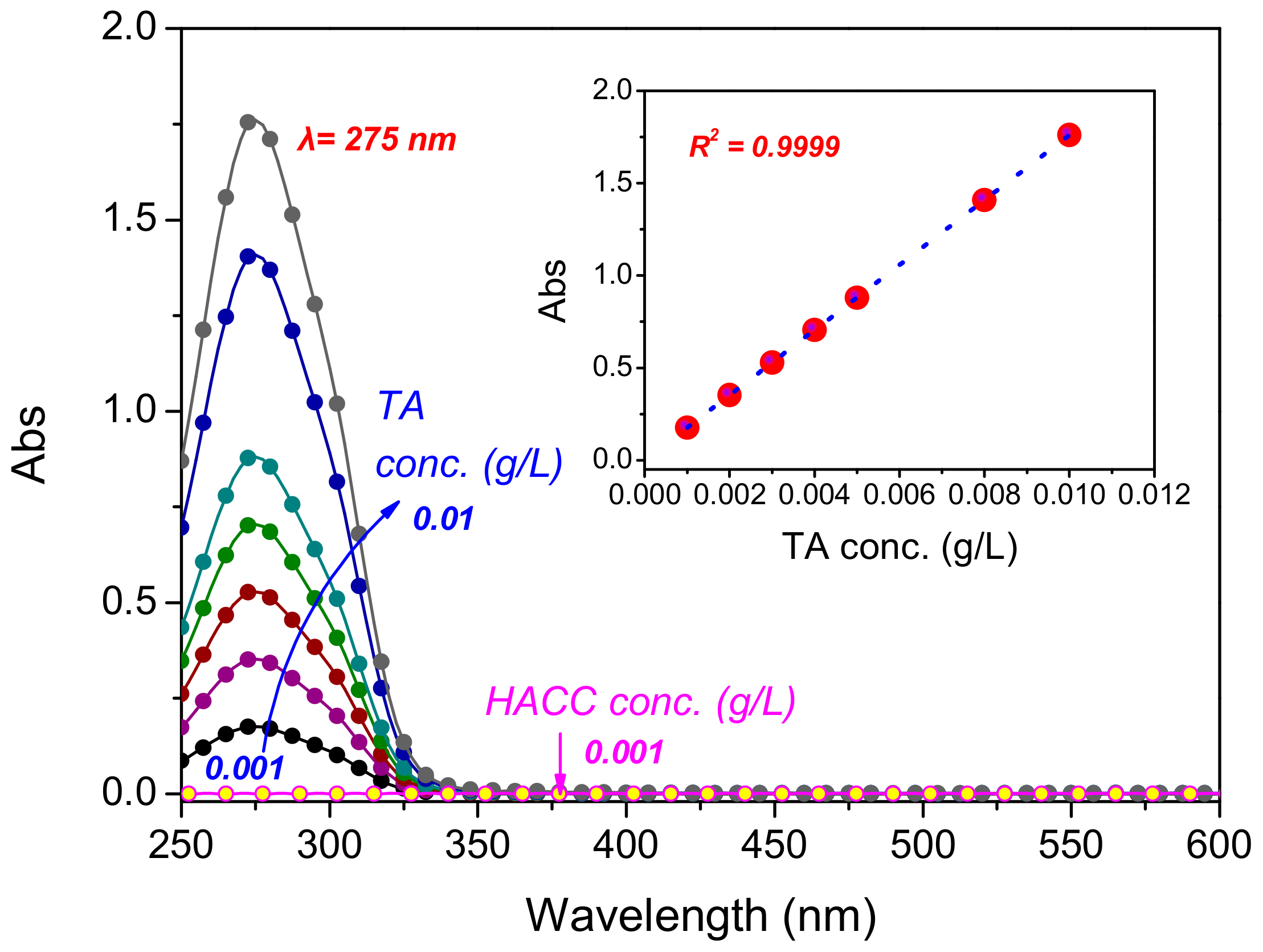

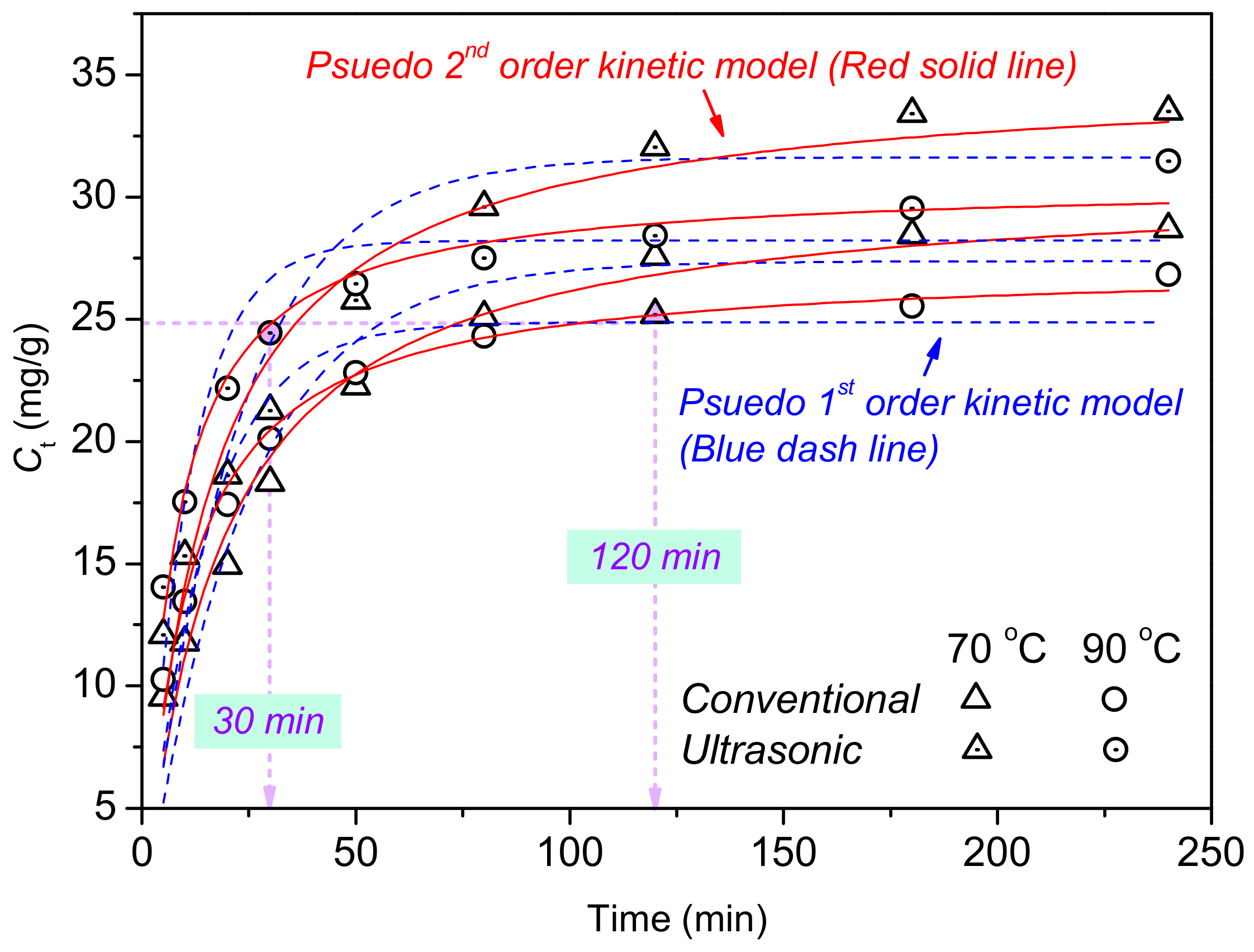

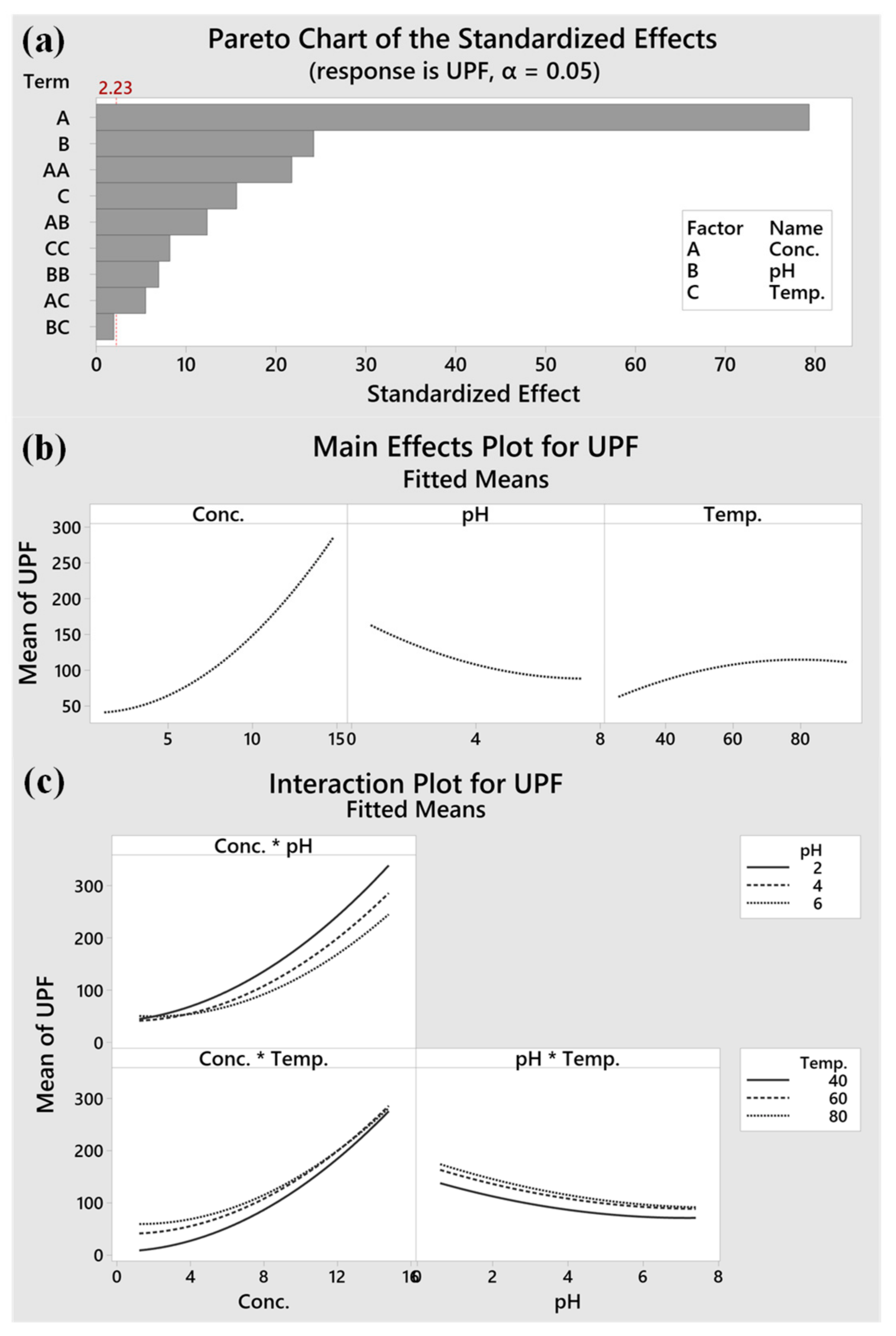
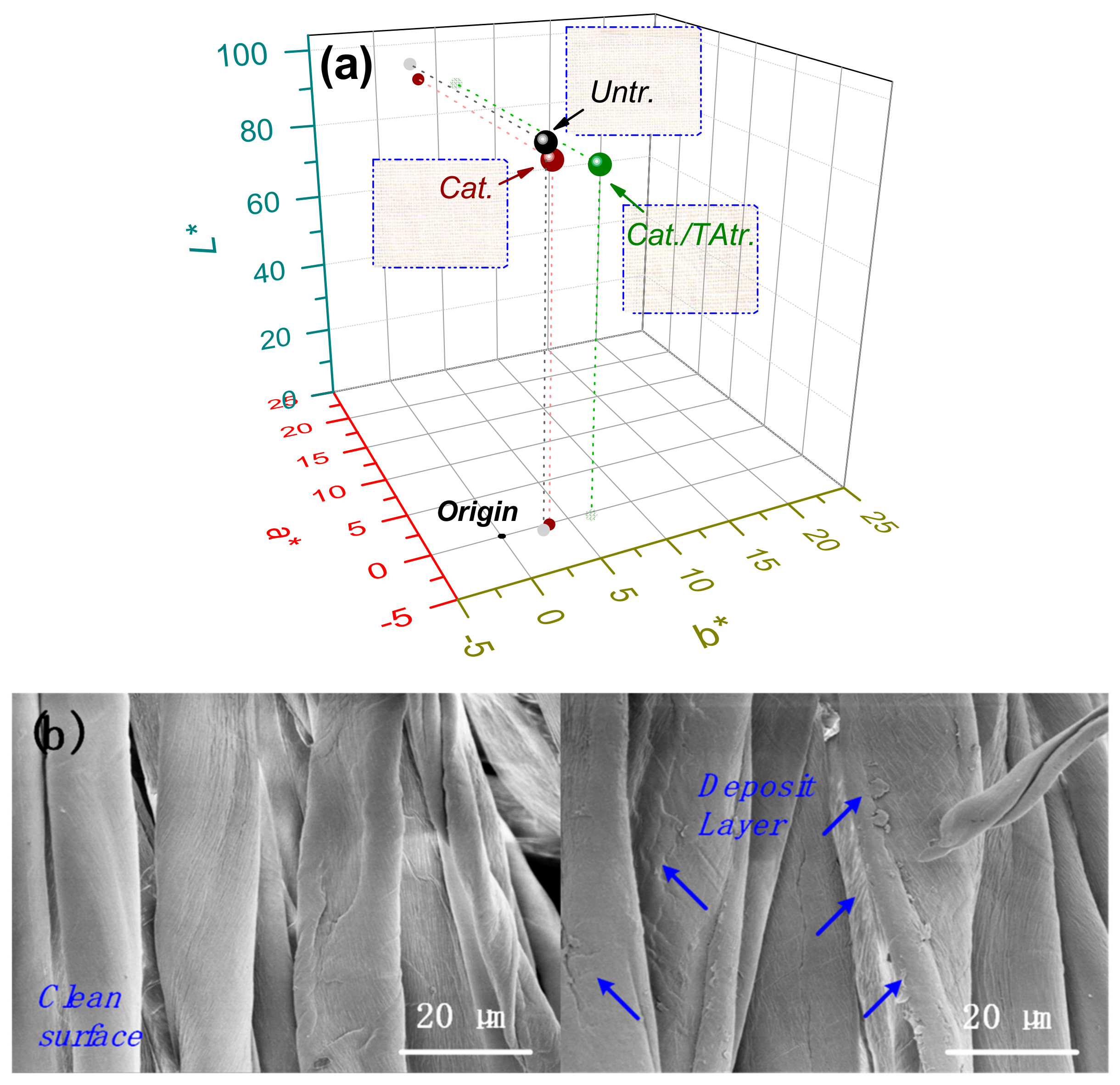

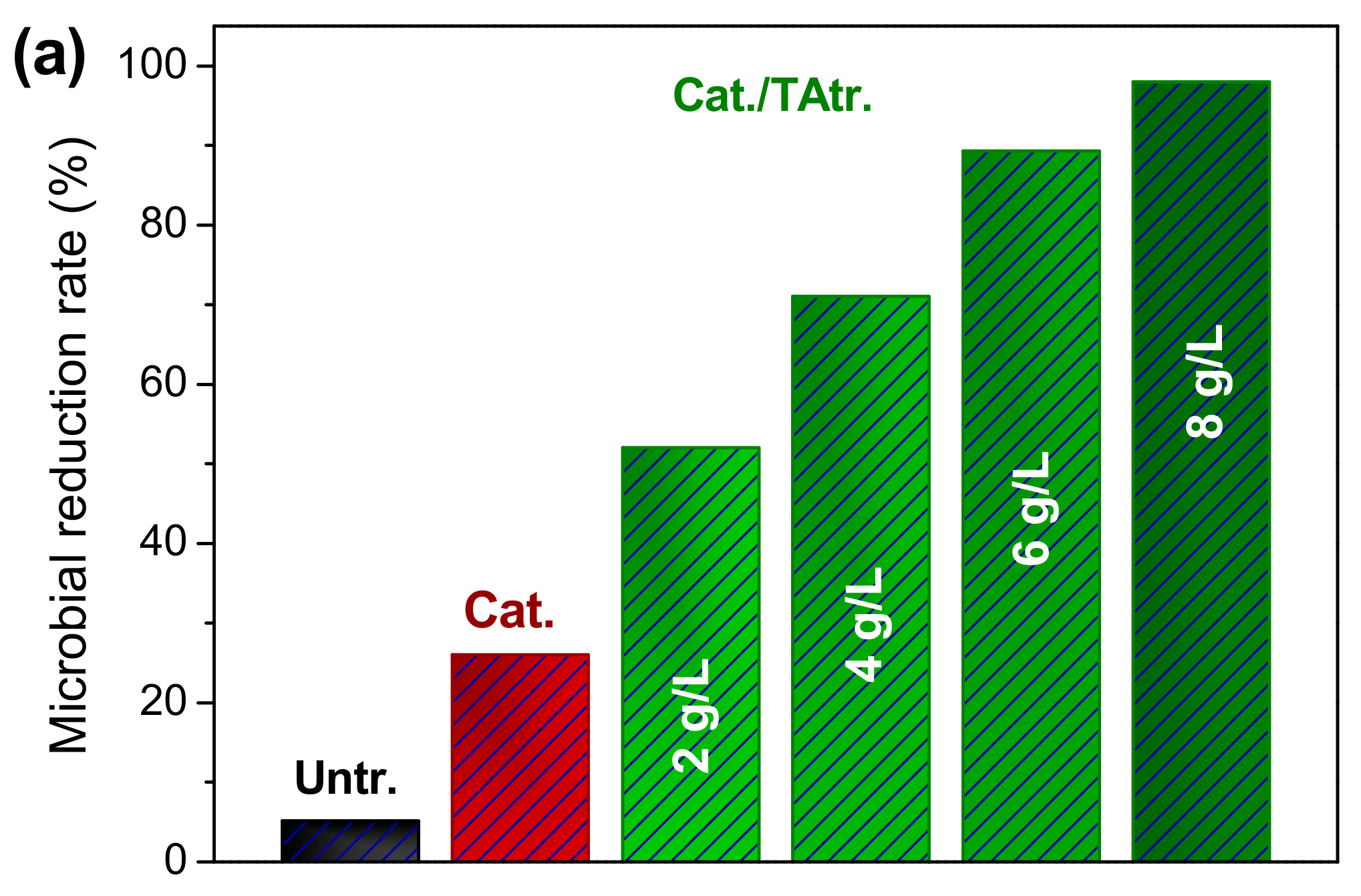

| Variables | Levels | ||||
|---|---|---|---|---|---|
| −α | −1 | 0 | 1 | α | |
| X1: Conc. (g/L) | 1.3 | 4 | 8 | 12 | 14.7 |
| X2: pH | 0.7 | 2 | 4 | 6 | 7.4 |
| X3: Temp. (°C) | 26.4 | 40 | 60 | 80 | 93.6 |
| Run | Conc. (g/L) | pH | Temp. (°C) | UPF | |
|---|---|---|---|---|---|
| Predicted | Actual | ||||
| 1 | 4 | 2 | 40 | 38.6 | 40.6 |
| 2 | 12 | 2 | 40 | 225.0 | 227.1 |
| 3 | 4 | 6 | 40 | 28.6 | 32.2 |
| 4 | 12 | 6 | 40 | 156.5 | 156.4 |
| 5 | 4 | 2 | 80 | 84.3 | 84.5 |
| 6 | 12 | 2 | 80 | 244.6 | 241.1 |
| 7 | 4 | 6 | 80 | 65.0 | 63.0 |
| 8 | 12 | 6 | 80 | 166.7 | 164.7 |
| 9 | 1.3 | 4 | 60 | 41.0 | 38.8 |
| 10 | 14.7 | 4 | 60 | 283.3 | 285.4 |
| 11 | 8 | 0.7 | 60 | 162.1 | 161.7 |
| 12 | 8 | 7.4 | 60 | 88.2 | 88.5 |
| 13 | 8 | 4 | 26.4 | 64.5 | 60.0 |
| 14 | 8 | 4 | 93.6 | 111.6 | 116.0 |
| 15 | 8 | 4 | 60 | 107.8 | 107.0 |
| 16 | 8 | 4 | 60 | 107.8 | 105.0 |
| 17 | 8 | 4 | 60 | 107.8 | 112.0 |
| 18 | 8 | 4 | 60 | 107.8 | 110.0 |
| 19 | 8 | 4 | 60 | 107.8 | 109.0 |
| 20 | 8 | 4 | 60 | 107.8 | 104.0 |
| 70 °C | 90 °C | |||
|---|---|---|---|---|
| Ultrasound | No | Yes | No | Yes |
| Pseudo 1st order kinetics | ||||
| k1 (/min) | 0.0425 | 0.0477 | 0.0701 | 0.0969 |
| Ce (mg/g) | 27.37 | 31.62 | 24.88 | 28.21 |
| R2 | 0.91 | 0.85 | 0.91 | 0.85 |
| ND (%) | 5.00 | 4.95 | 3.15 | 2.54 |
| Pseudo 2nd order kinetics | ||||
| k2 (g/[mg⋅min]) | 0.0019 | 0.0020 | 0.0037 | 0.0047 |
| Ce (mg/g) | 30.73 | 35.12 | 27.26 | 30.61 |
| hi (mg/[g⋅min]) | 1.79 | 2.47 | 2.75 | 4.40 |
| t1/2 (min) | 17.13 | 14.24 | 9.91 | 6.95 |
| R2 | 0.97 | 0.95 | 0.98 | 0.97 |
| ND (%) | 3.01 | 2.72 | 1.22 | 0.98 |
| Source | DF | Adj SS | Adj MS | F-Value | p-Value |
|---|---|---|---|---|---|
| Model | 9 | 89,065.6 | 9896.2 | 716.05 | 0.000 |
| Linear | 3 | 80,117.9 | 26,706.0 | 1932.33 | 0.000 |
| Conc. | 1 | 70,849.3 | 70,849.3 | 5126.36 | 0.000 |
| pH | 1 | 6593.1 | 6593.1 | 477.05 | 0.000 |
| Temp. | 1 | 2675.5 | 2675.5 | 193.58 | 0.000 |
| Square | 3 | 6842.5 | 2280.8 | 165.03 | 0.000 |
| Conc. * Conc. | 1 | 5317.9 | 5317.9 | 384.78 | 0.000 |
| pH * pH | 1 | 540.0 | 540.0 | 39.07 | 0.000 |
| Temp. * Temp. | 1 | 706.3 | 706.3 | 51.10 | 0.000 |
| 2-Way Interaction | 3 | 2105.3 | 701.8 | 50.78 | 0.000 |
| Conc. * pH | 1 | 1719.0 | 1719.0 | 124.38 | 0.000 |
| Conc. * Temp. | 1 | 341.7 | 341.7 | 24.72 | 0.001 |
| pH * Temp. | 1 | 44.5 | 44.5 | 3.22 | 0.103 |
| Error | 10 | 138.2 | 13.8 | ||
| Lack-of-Fit | 5 | 91.4 | 18.3 | 1.95 | 0.240 |
| Pure Error | 5 | 46.8 | 9.4 | ||
| Total | 19 | 89,203.8 | |||
| Model Summary | |||||
| S | R-sq | R-sq (adj) | R-sq (pred) | ||
| 3.7176 | 99.85% | 99.71% | 99.13% | ||
Publisher’s Note: MDPI stays neutral with regard to jurisdictional claims in published maps and institutional affiliations. |
© 2022 by the authors. Licensee MDPI, Basel, Switzerland. This article is an open access article distributed under the terms and conditions of the Creative Commons Attribution (CC BY) license (https://creativecommons.org/licenses/by/4.0/).
Share and Cite
Zhou, Y.; Zheng, F.; Wang, J. Ultrasonic-Aided Co-Precipitation of Tannins and Chitosan Ammonium Salt on Cotton Fabric for Antimicrobial and Ultraviolet-Shielding Properties: An Efficient, Colourless, and Eco-Finishing Strategy. Materials 2022, 15, 4367. https://doi.org/10.3390/ma15124367
Zhou Y, Zheng F, Wang J. Ultrasonic-Aided Co-Precipitation of Tannins and Chitosan Ammonium Salt on Cotton Fabric for Antimicrobial and Ultraviolet-Shielding Properties: An Efficient, Colourless, and Eco-Finishing Strategy. Materials. 2022; 15(12):4367. https://doi.org/10.3390/ma15124367
Chicago/Turabian StyleZhou, Yuyang, Feiyang Zheng, and Jingjing Wang. 2022. "Ultrasonic-Aided Co-Precipitation of Tannins and Chitosan Ammonium Salt on Cotton Fabric for Antimicrobial and Ultraviolet-Shielding Properties: An Efficient, Colourless, and Eco-Finishing Strategy" Materials 15, no. 12: 4367. https://doi.org/10.3390/ma15124367
APA StyleZhou, Y., Zheng, F., & Wang, J. (2022). Ultrasonic-Aided Co-Precipitation of Tannins and Chitosan Ammonium Salt on Cotton Fabric for Antimicrobial and Ultraviolet-Shielding Properties: An Efficient, Colourless, and Eco-Finishing Strategy. Materials, 15(12), 4367. https://doi.org/10.3390/ma15124367







